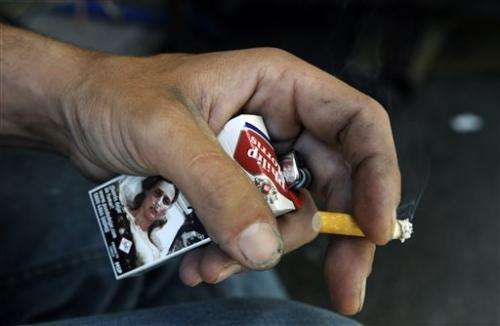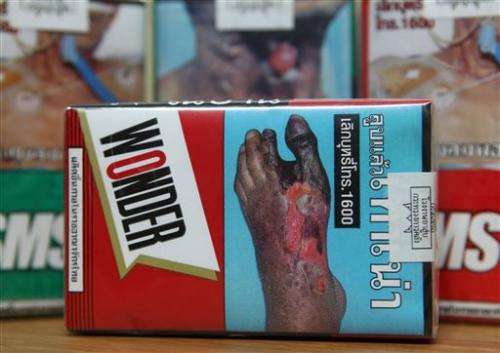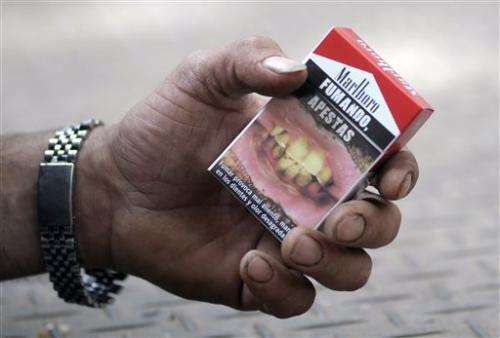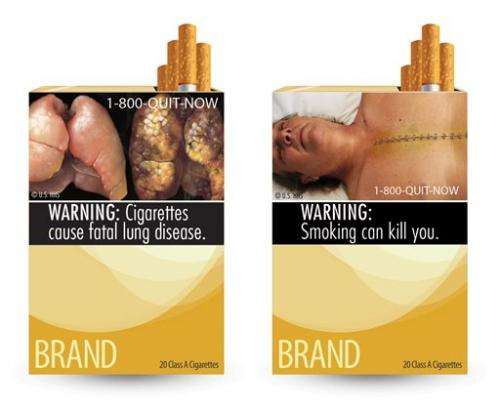More countries adding graphic warnings to smokes

Indonesia became the newest country to mandate graphic photo warnings on cigarette packs on Tuesday, joining more than 40 other nations or territories that have adopted similar regulations in recent years.
The warnings, which showcase gruesome close-up images ranging from rotting teeth and cancerous lungs to open tracheotomy holes and corpses, are an effort to highlight the risks of health problems related to smoking. Research suggests these images have prompted people to quit, but the World Health Organization estimates nearly 6 million people continue to die globally each year from smoking-related causes. The tobacco industry has fought government efforts to introduce or increase the size of graphic warnings in some countries. Here are a few places where pictorial health warnings have made headlines:
____
INDONESIA:
THE LAW: 40 percent of pack covered by graphic photos.
TIMING: Deadline to be on shelves was June 24.
BACKGROUND: Many tobacco companies missed Tuesday's deadline to comply with the new law requiring all cigarette packs in stores to carry graphic warning photos. Indonesia, a country of around 240 million, has the world's highest rate of male smokers at 67 percent and the second-highest rate overall. Its government is among the few that has yet to sign a World Health Organization treaty on tobacco control.
____
THAILAND:
THE LAW: Portion of cigarette packs that must be covered with graphic health warnings rising from 55 percent to 85 percent.
TIMING: Change will take effect in September.

BACKGROUND: Last year, the Public Health Ministry issued a regulation increasing the level of coverage to 85 percent. Tobacco giant Philip Morris and more than 1,400 Thai retailers sued, and a court temporarily suspended the order. On Thursday, the Supreme Administrative Court ruled that the regulation can take effect before a lower court reaches a final verdict in the lawsuit.
____

AUSTRALIA:
THE LAW: No cigarette brand logos permitted; graphic health warnings required on 75 percent of front and 90 percent of back.
TIMING: Plain packaging law went into effect in 2012.
BACKGROUND: Australia became the first country in the world to mandate plain cigarette packs with no brand logo or colors permitted. Instead, the packs are solid brown and covered in large graphic warnings. Tobacco companies fought the law, saying it violated intellectual property rights and devalued their trademarks, but the country's highest court upheld it. Figures released this month by the country's Bureau of Statistics found that cigarette consumption fell about 5 percent from March 2013 to the same period this year. The World Trade Organization has agreed to hear complaints filed by several tobacco-growing countries, but other governments have expressed interest in passing similar laws. Smokers make up 17 percent of Australia's population.
____

UNITED STATES:
THE LAW: No graphic pictures on packs.
TIMING: The government stepped away from a legal battle with tobacco companies in March 2013.
BACKGROUND: There are currently no pictorial warnings on cigarette packs in the U.S. After the tobacco industry sued, a Food and Drug Administration order to include the graphic labels was blocked last year by an appeals court, which ruled that the photos violated First Amendment free speech protections. The government opted not to take the case to the U.S. Supreme Court, but will instead develop new warnings. About 18 percent of adult Americans smoke.
____

PHILIPPINES:
THE LAW: Graphic warning legislation approved this month requires 50 percent of bottom of the pack to be covered by graphic warnings.
TIMING: Legislation awaits president's signature.
BACKGROUND: The Philippines is expected to join a handful of other countries that put graphic warnings at the bottom of their packs, meaning they are not visible when displayed on store shelves. Anti-smoking advocates say labels on the bottom of the packs are less effective, and have denounced tobacco industry involvement in the implementation process. Health officials said around 17 million people in the country of 96 million, or 18 percent, smoked in 2012.
____

URUGUAY:
THE LAW: Graphic warnings cover 80 percent of packs.
TIMING: Regulations implemented in 2010.

BACKGROUND: Uruguay, a leader in strict tobacco controls, mandated what were the largest graphic warnings ever in 2010. Eighty percent of packs must be covered by the labels, including one depicting a person smoking a battery to show that cigarettes contain the toxic metal cadmium. Uruguay has backed Australia at the WTO, telling the trade body that smoking is "the most serious pandemic confronting humanity." Philip Morris International sued Uruguay over the law; the case is still pending.
© 2014 The Associated Press. All rights reserved.
















